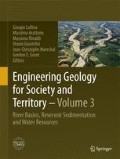Abstract
Important goals for studying dam removal are to learn how rivers respond to large and rapid introductions of sediment, and to develop predictive models to guide future dam removals. Achieving these goals requires organizing case histories systematically so that underlying physical mechanisms determining rates and styles of sediment erosion, transport, and deposition are revealed. We examine a range of dam removals predominantly in the western US over the last decade, and extract useful lessons and trends that can be used to predict the response of rivers to future removals.
Access this chapter
Tax calculation will be finalised at checkout
Purchases are for personal use only
References
Bromley C, Randle T, Grant G, Thorne C (2011) Physical modeling of the removal of Glines Canyon Dam and Lake Mills from the Elwha River, WA. In: Papanicolaou A, Barkdoll B (eds) Sediment dynamics upon dam removal, ASCE manuals and reports on engineering practice No 122. American Society of Civil Engineers, Reston, pp 97–113
Burroughs B, Hayes D, Klomp K, Hansen J, Mistak J (2009) Effects of Stronach dam removal on fluvial geomorphology in the Pine River, Michigan, United States. Geomorphology 110:96–107
Cui Y, Wilcox A (2008) Development and application of numerical models of sediment transport associated with dam removal. In: Garcia MH (ed) Sedimentation engineering: processes, measurements, modeling, and practice, ASCE manuals and reports on engineering practice No. 110. American Society of Civil Engineers, Reston, pp 995–1010
Downs P, Cui Y, Wooster J, Dusterhoff S, Booth D et al (2009) Managing reservoir sediment release in dam removal projects: an approach informed by physical and numerical modelling of non‐cohesive sediment. Int J River Basin Manag 7:433–452
Doyle MW, Stanley EH, Harbor JM (2003a) Channel adjustments following two dam removals in Wisconsin. Water Res Res. doi:10.1029/2002WR001714
Doyle MW, Stanley EH et al (2003b) Dam removal in the United States: emerging needs for science and policy. EOS 84:32–33
Grant G, Marr J, Hill C, Johnson S, Campbell K et al (2008) Experimental and field observations of breach dynamics accompanying erosion of Marmot cofferdam, Sandy River, Oregon. In: Babcock RW (ed) Proceedings world environmental and water resources congress 2008. Ahupua’a. Curran Associates, Inc., Red Hook. doi:10.1061/40976(316)350
Major J, O’Connor J, Podolak C, Keith M, Grant G et al (2012) Geomorphic response of the Sandy River, Oregon, to removal of Marmot dam. US geological survey professional paper 1792. U.S. Geological Survey, Reston
O’Connor J, Major J, Spicer K, Mosbrucker A, Uhrich M et al (2012) Immediate downstream hydrologic and geomorphic response to the Condit Dam removal, White Salmon River, Washington. Geol Soc Am Abs Programs 44(7):42
Sawaske S, Freyburg DL (2012) A comparison of past small dam removals in highly sediment-impacted systems in the U.S. Geomorphology 151:50–58
Service R (2011) Will busting dams boost Salmon? Science 334:888–892
Stewart G, Grant G (2006) What can we learn from the removal of little dinky dams? In: Moglen (ed) Managing watersheds for human and natural impacts: proceedings of the 2005 watershed management conference, 19–22 July, 2005, Williamsburg, VA. American Society of Civil Engineers, Reston, pp 1–7
Walter C, Tullos D (2010) Downstream channel changes after a small dam removal: using aerial photos and measurement error for context; Calapooia River, Oregon. River Res Appl 26:1220–1245. doi:10.1002/rra.1323
Author information
Authors and Affiliations
Corresponding author
Editor information
Editors and Affiliations
Rights and permissions
Copyright information
© 2015 Springer International Publishing Switzerland
About this paper
Cite this paper
Grant, G.E., Lewis, S.L. (2015). The Remains of the Dam: What Have We Learned from 15 Years of US Dam Removals?. In: Lollino, G., Arattano, M., Rinaldi, M., Giustolisi, O., Marechal, JC., Grant, G. (eds) Engineering Geology for Society and Territory - Volume 3. Springer, Cham. https://doi.org/10.1007/978-3-319-09054-2_7
Download citation
DOI: https://doi.org/10.1007/978-3-319-09054-2_7
Published:
Publisher Name: Springer, Cham
Print ISBN: 978-3-319-09053-5
Online ISBN: 978-3-319-09054-2
eBook Packages: Earth and Environmental ScienceEarth and Environmental Science (R0)

